Eimskip And Samskip

Iceland is a land of glaciers, volcanoes and hot springs, with the tremendous dust cloud of April 2010 from the enormous Eyjafjallajokull volcano creating a ‘no fly zone’ over most of Europe for more than a week. Iceland is very remote with its northern shore almost touching the Arctic Circle, which in fact cuts through the offshore island of Grimsey, and it’s most southerly point is 850 kilometres from Scotland. Glaciers, snow and ice permanently cover one ninth of the island, with the Vatnajokull glacier the largest in Europe, and lava fields cover another ninth of the island. The Vikings were the first settlers in AD874 and it’s people united with Denmark in the 14th century. In 1874, Iceland was granted limited Home Rule from Denmark, and in December 1918 it became an independent state while still accepting the King of Denmark as monarch and with Denmark providing its defence and foreign affairs. Steamship services to Seydisfjordur, Ofjordur, Isafjordur and Reykjavik had been provided by DFDS of Copenhagen since its inception in 1866.
Eimskip
This movement towards national independence had also founded the first shipping company on 17th January 1914 as the Icelandic Steamship Co. Ltd. (Hf Eimskipafelag Island). Although promoted by the island leaders as a State owned company, the truth is that it was an example of private enterprise. Some 1,500 Icelanders attended the constituent meeting held in a Reykjavik church as there was no other building big enough to accommodate their numbers. Some 14,000 shareholders, then 15% of the island population, took part of the 1.69075 million Icelandic kroner authorized capital. Eimskip chose a strong symbol on its houseflag for its venture of a blue cross symbolizing the hammer of Thor, the Nordic god of thunder, although this symbol is no longer used. Two vessels were immediately ordered from Kjobenhavns Flydok and Skibs, a passenger and cargo vessel named Gullfoss after Iceland’s most beautiful and famous waterfall, and a cargo ship named Godafoss, and all subsequent Eimskip ships have been named after waterfalls. Gullfoss of 1,414 grt was completed in 1915 with a black hull and two holds forward and one aft of her brown painted superstructure with a tall steam funnel, and had six derricks on two masts for cargo handling. Godafoss of 1,374 grt was also completed in 1915, both ships being powered by triple expansion steam engines by the shipbuilder to provide power for the long rough voyage from Reykjavik to Copenhagen.
Godafoss was unfortunately lost on 3rd November 1916 when she grounded at Straumness off North West Iceland. The aptly named steamer Profit of 1,135 grt, completed by Nylands Verksted in Oslo in 1904, was purchased in 1917 and renamed Lagarfoss. Three more old steamers had been purchased by 1920 including the well decked steamer Borg of 762 grt built as Ionian in 1901 at Greenock for F.J. Coxhead of London. The other pair of steamers were the Leith built Sterling of 1,040 grt dating from 1890, and the Porsgrund built steamer Villemoes of 775 grt built in 1914 and later renamed Selfoss. Eimskip completed its stylish headquarters building in 1921 as the dominating building overlooking Reykjavik harbour and which served in that capacity until sold in 2003 for redevelopment as a four star hotel. Also in 1921, a new Godafoss cargo steamer of 1,542 grt was completed at Svendborg in Denmark, followed by the smaller Esja of 728 grt in 1923 from Kjobenhavns Flydok, to give a small fleet of five steamers in 1925. The passenger steamer Bruarfoss of 1,580 grt was completed in 1927 by the same shipbuilder, followed by an exact sister Dettifoss in 1930 from Fredrikshavn Vaerft.

A fleet of seven steamers was operated during the Depression years, and the same size of fleet at the start of World War II until Gullfoss was seized at Copenhagen by the German forces in April, 1940. British forces landed in Iceland a month later to take control as there were no Danish troops to oppose a German landing. In 1941, American forces took over the defence of the country from the British and stayed on after the end of the war. Two Eimskip vessels were lost to enemy action, Godafoss on 10th November 1944 when torpedoed and sunk by U300 off Gardskagi, Iceland in position 66.08° N, 22.45° W with 25 lives lost and 21 survivors while on a voyage from Loch Ewe to Reykjavik. The vessel had proceeded to pick up survivors against orders from the torpedoed British tanker Shirvan and was torpedoed just after completing this rescue work and sank in four minutes. Dettifoss was torpedoed and sunk by U1064 on 21st February 1945 in the North Channel of the Irish Sea while on a voyage from Belfast to Iceland with fifteen lives lost and thirty survivors.
Four war replacements were ordered at the end of the war for completion during 1948 to 1950. The largest was the passenger motor vessel Gullfoss of 3,858 grt with accommodation for 225 passengers and a speed of 15.5 knots from a 12-cylinder 2SCSA oil engine from her builders, Burmeister & Wain of Copenhagen. She had dimensions of 355 feet by 47.7 feet with a long bridge deck extending some 186 feet, and was a shelterdecker with three sparred decks in nos 1,3, 4 and 5 holds. She was strengthened for navigation in ice on her triangular route from Reykjavik to Leith and Copenhagen, and was a good looking motorship with refrigerated capacity for fish cargoes and had a cruiser stern. A trio of cargoships named Godafoss, Dettifoss and Lagarfoss of 2,925 grt and 2,675 dwt were completed in that order by the same Copenhagen shipbuilder during 1948/49. They had grey hulls on dimensions of 295 feet by 46 feet and were shelterdeckers with three decks in the two forward holds and two decks in the two aft holds. The basic ‘midships accommodation block was painted white and a 9-cylinder B & W 2SCSA oil engine gave a speed of 12 knots with refrigerated holds for the carriage of fish cargoes and they were strengthened for navigation in ice.
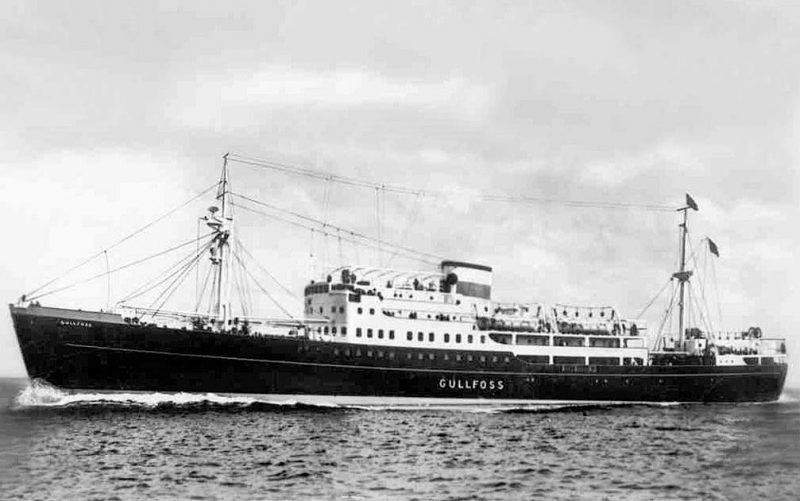
An engines aft standard American built C1-M-AV1 type was purchased in 1948 and renamed Trollafoss and operated to American ports with timber and American forces military cargo. A fleet of eight ships was being operated in 1950, rising to ten ships in 1959, twelve ships in 1965, and eighteen ships by 1975. Some of the more interesting additions to the fleet during this period included the Italian vessel Gemito of 2,553 grt and 3,070 dwt, purchased in 1951 and renamed Reykjafoss, having been completed at Taranto in 1947 by Franco Tosi spA. The new Bruarfoss of 3,137 grt and 4,065 dwt in 1960 from the Aalborg Vaerft yard had two holds forward of the bridge, and one aft, with derricks on bipod masts serving the forward holds, and two derricks on a pair of kingposts serving the aft hold. The Danish vessel Mille Heering of 2,360 dwt was purchased in 1963 from Cherry Heering Line (Peter F. Heerns, Copenhagen) and renamed Bakkafoss, having been completed in 1958 by the Aarhus Flydok und Mask yard. In the same year, the Danish vessel Ketty Danielsen was purchased from Otto L.E. Danielsen of Copenhagen and renamed Manafoss. She had a curved ‘wraparound’ bridge overlooking her twin holds, which were served by seven derricks positioned on two masts.
Two engines aft refrigerated sisters of 3,870 dwt were completed in 1965 by Aalborg Vaerft as Reykjafoss and Skogafoss, and were equipped with derricks on three goalpost and bipod masts. The same yard delivered a trio of refrigerated sisters of 4,450 dwt to Eimskip in 1970 named Dettifoss, Godafoss and Manafoss. Cargo handling for their twin holds was performed by derricks on one forward mast and by three cranes. The doyen of the fleet, the passenger vessel Gullfoss dating from 1950, was sold in 1973 to Fouad A. Khayat of Saudi Arabia and renamed Mecca to end Eimskip passenger services. An octet of cargo ships of 3,100 dwt was purchased during 1974/75, five of them being twin funnelled ships from the Mercandian Rederiene fleet of Per Henriksen of Copenhagen, and were renamed Alafoss, Grundarfoss, Irafoss, Ljosafoss, Mulafoss, Tungufoss, Udafoss and Urridafoss. Tungufoss later sank on 19th September 1981 off Land’s End while on a voyage from Iceland. Two other Eimskip vessels became casualties at this time, with Bruarfoss of 1960 seriously damaged in a collision in 1980 off Lockport (Nova Scotia) and was condemned by insurance assessors as a total loss but was later repaired and sold for further trading. The chartered vessel Berglind of 3,066 grt completed in 1970 sank on 20th July 1981 off Sydney (CB) while under tow after a collision during the previous day while on a voyage from Hampton Roads to Reykjavik.
A refrigerated fish and pallet carrier was purchased in 1977 from Joklar Hf, Iceland as Hofsjokull and renamed Studlafoss. She had been completed in June 1964 by the Grangemouth Dockyard Co. Ltd. as a twin hold four hatch reefer with cargo derricks on two masts, and a service speed of 14 knots from her Klockner Humboldt Deutz diesel engine. Ro-ro vessels accepting trailers of fish and similar commodities into their refrigerated holds began to be chartered in 1980. Alafoss was the former Dana Atlas of Dana Atlas A/S, Denmark, and her sister Eyrarfoss was the former Mercandian Importer of Per Henriksen, both completed in 1978. The pair were purchased after a one year charter and lengthened in 1985 before being sold on in 1989 after nine years trading with Eimskip. Containers, both refrigerated and non-refrigerated, were also carried on the chartered Ellerman Lines container ships City of Oxford and City of Hartlepool of 296 TEU, the former being chartered for four years from 1983 as Bakkafoss, and the latter as Laxfoss for one year from 1984. Larger container ships were later owned e.g. Bruarfoss of 1,012 TEU completed in Poland in 1996, while others of up to 1,450 TEU were chartered or purchased from Maersk Line (Maersk Euro Quatro, Maersk Santiago, Maersk Quinto, Maersk Georgetown), and Nedlloyd (Nedlloyd Dragon) and Borchard Line (Rachel Borchard) and given ‘Foss’ Icelandic waterfall names.

In November 1990, the Icelandic shipping company Skipafelagio Ok Hf was taken over, together with two vessels including one that had previously been owned, Ljosafoss of 1972. The Eimskip fleet in the 1990s, colloquially known as the ‘Ice Maiden fleet’, was carrying large numbers of their own branded refrigerated Eimskip containers and Maersk Line containers. By the Millennium, Eimskip was the leading maritime transport company in Iceland with ten owned ships and a varying number of time chartered vessels, and had a staff of 1,100 seafarers and headquarters office staff. There were also offices and subsidiaries in eleven countries with services to the Faroes, Continental Europe, U.K., Scandinavia and America and Canada. Eimskip turnover in 2003 was £23 million with excellent profits after takeover by Icelandic bank Landsbanki in September 2002. By August 2008, Eimskip had a large fleet of owned refrigerated cargo ships and feeder container ships with many more on charter, traditional names being given to Bruarfoss, Dalfoss, Dettifoss, Godafoss, Holmfoss, Irafoss, Langfoss, Laxfoss, Polfoss, Reykjafoss, Selfoss, Skogafoss, Storfoss and Svartfoss. Eimskip funnel colours had now been changed from the traditional white with a central blue band to feature the new Eimskip logo of a blue ‘E’ on a silver/grey background. The new funnel colours were white with a black top and a blue base with the new Eimskip logo on the white part. The Icelandic State owned ferry Herjolfur 3,354/92 was also managed, as was the Nordlink ferry Norland 2,655/76, and Faroe Ferry Blikur 2,854/79.
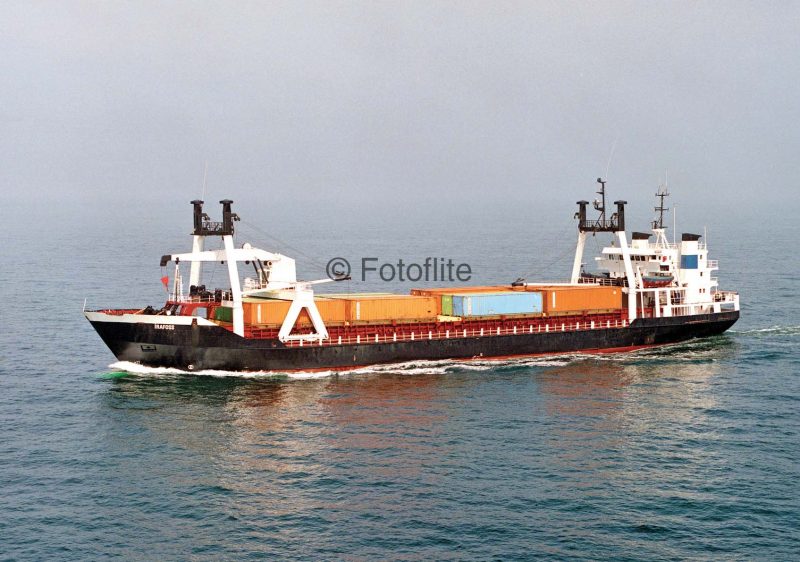
However, the collapse of all three major Icelandic banks including Landsbanki in October 2008 caused huge problems for Eimskip as it was their major shareholder, and Dalfoss, Langfoss and Storfoss were sold a few months later by creditors. The green hulled chartered container ship Reykjafoss of 8,430 dwt ex Westersingel ran aground on the evening of 29th April 2011 at Argentia in Newfoundland. She was on a scheduled voyage from Norfolk (Va), Everett (Mass) and Halifax (NS) to Reykjavik. The vessel lost power when her engine stopped and she was refloated later and towed into harbour, no-one was injured but the vessel could not continue her voyage as she had suffered a bent propeller. A decision of General Average was declared for her shipper’s cargo.
The current Eimskip services are now given in some detail:-
North Atlantic Liner Services
Weekly EIMSKIP container services between Iceland and major ports in Continental Europe, Britain and Scandinavia, and a biweekly service from Iceland to America and Canada.
Faroe Islands
In association with Faroe Ship, which was established in 1919 and is the leading transportation company in the Faroe Islands, offering liner services from Faroes to Scandinavia, Continental Europe, Britain, Iceland, America and Canada. Faroe Express is the brand name of Faroe Ship and focuses on forwarding, airfreight and various other logistics solutions.
Norway
EIMSKIP-CTG operates a weekly liner service with multipurpose reefer vessels sailing from Murmansk along the Norwegian coast to Holland and the U.K. Also, bulk transport of frozen and chilled cargo on its fleet of modern reefer vessels in the North Atlantic, Baltic, Mediterranean and West African trades with heavy lift and project cargo accepted.
Newfoundland
The hub port of Argentia in Newfoundland is served by regular EIMSKIP sailings by container ships, with some en route to the U.S.A. and Canada. Regular FCL and LCL container service between Newfoundland and Continental Europe, Britain, Scandinavia and a direct connection to the U.S.A.
Transatlantic Services
Richmond (Va), Boston (Mass) and Halifax (NS) and Argentia (NFL) to Europe and Scandinavia, Baltic and Russia via the transshipment hub in Reykjavik. Heavy lift, project cargo, shippers own containers etc. are all accepted.
Greenland
EIMSKIP is the agent in the U.S.A., Canada, Continental Europe, Britain and Iceland for the Greenland State owned Royal Arctic Line (RAL). A regular service operates from Denmark to Iceland and Greenland.
Logistics
Many services including reefer forwarding, container and general cargo forwarding, warehousing, cold storage, particularly in the carriage of fish and perishable commodities from Alaskan and Canadian ports in the Arctic and Bering Sea.
Two new container ships of 12,000 dwt were ordered in September 2011 from China just three years after the company nearly collapsed under the weight of its debt. The ships are of German design and have dimensions of 140 metres by 23 metres with a total cost of €36.3 million. Eimskip operating profit for the first nine months of 2011 was €34.5 million and after tax €12.5 million. A cargo of 1,600 tonnes of palletized refractory stones and refractory cement was loaded aboard the motorvessel Svarfoss on 18th August 2011 in Germany for delivery by Eimskip Germany to Murmansk, and a further 500 tonnes of general cargo was also sent to Murmansk. The Eimskip vessel Skogafoss of 700 TEU capacity had joined the fleet at this time for liner operations in the North Atlantic, and the Eimskip motto of ‘Navigare neccesse est’ – ‘Sailing is a necessity’ is lived to its full meaning today, as the company celebrated its centenary in January 2014.
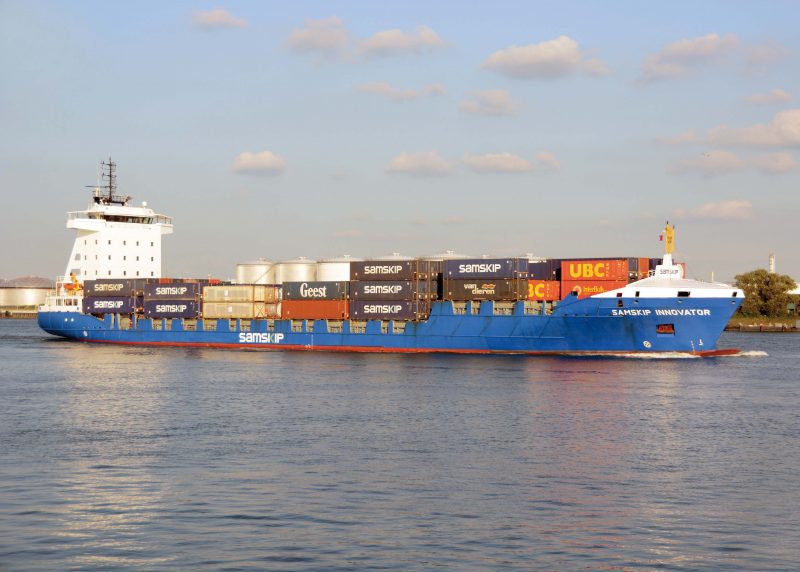
Samskip
The movement towards Icelandic independence from Denmark also produced a second shipping company when the Federation of Icelandic Co-operative Societies (Samband Island Samvinnuf-elaga) was formed in 1920. A one third share in the 600 tonne schooner Svala was purchased but she was unfortunately wrecked a short time after entering service. In 1934, the Akureyri Co-operative in the north of Iceland salvaged a ship which had run aground near Siglufjord, repaired her and renamed her Snaefell. She was of 751 grt and had been built in 1901 at Stavanger as Thyra and had been wrecked under the name of Kongshaug. She traded successfully for Samband until she was immobilized in Scandinavia following the German occupation in 1940, and thus shipping operations were suspended for the duration of the war.
Samband Line was back in business with regular services from Iceland to Hull and Rotterdam in early post war years with two new ships, Hvassafell built in 1946 and Arnarfell built in 1949. Hvassafell of 1,690 grt was built by the Ansaldo yard at Genoa-Voltri and was given an Italian 6-cylinder oil engine manufactured by the builder. Arnarfell of 1,381 grt was completed by Solvesborgs Verft and was a smart looking shelterdecker with a cruiser stern and powered by a 5-cylinder Atlas diesel engine. Helgafell of 3,300 dwt was completed in September 1954 by the Oskarshamns Varv A/B yard as a shelterdecker powered by a 5-cylinder diesel engine by Nyquist & Holm A/B. By 1962, the fleet had been built up to seven ships, all with names ending in ‘fell’, which means mountain in Icelandic. This included a large deep sea tramp tanker of 16,730 dwt named Hamrafell, purchased in 1956, and two coastal tankers, Litlafell and Stapafell. The Samband Line fleet was also engaged in tramping from ports on both sides of the North Atlantic in addition to an Iceland to Europe liner service.


Samband Line had a fleet of seven ships in 1975 including the shelterdecker Maelifell of 2,800 dwt completed in 1964, and two new ships of 2,650 dwt completed in 1971 as Hvassafell and Skaftafell for the liner service. The regular service from Reykjavik now called at Larvik, Copenhagen, Svendborg, Antwerp, Rotterdam and Hull and other ports if inducement offered, and a service also ran to Halifax (NS) and American ports. Arnarfell and Helgafell of 3,100 dwt were purchased in 1979 from Per Henriksen as Mercandian Exporter and Mercandian Shipper and had five sisters in the Eimskip fleet. Larger vessels able to carry significant container and break bulk cargoes were then owned during the 1980s decade e.g. Helgafell of 7,430 dwt and 644 TEU capacity purchased in 1987, ice strengthened and with decks strengthened for heavy cargoes.
In 1991, with eight owned ships in the fleet, Samband Line was converted into a limited liability company Samskip Hf, with Samband Co-operative Societies owning 85% of the share capital. A major reconstruction of company activities was implemented in 1993, which reduced the fleet from ten ships to four ships and the number of employees by 35%, with new trade routes opened. Unfortunately, the Samskip flagship, the owned Disarfell, sank in March 1997 while on a voyage from Iceland to the Faroes and the Continent with the loss of two crew members. A further loss occurred in February, 2005 when the chartered vessel Jokulfell foundered to the North East of the Faroes while on a voyage from Denmark to Iceland with the loss of six crew members. The Icelandic State owned ferry Herjolfur was managed for five years from the first day of 2001 until the last day of 2005, when management was transferred to Eimskip. From this point of time until recently, a fleet of four owned or chartered of up to 908 TEU and 10,950 dwt with the names of Akrafell, Arnarfell, Helgafell and Hvassafell have been operated on the Icelandic liner service.
In 2005, Samskip acquired the Geest North Sea Line from Dutch owners and the British Seawheel short sea operator, to expand the Samskip portfolio into North Sea trade into Hull and Goole. Samskip also acquired reefer cold stores from Kloosterboer of Holland at this time, extending its cold storage capacity to 90,000 tonnes, as well as Van Dieren Maritime and a 40% share in Silver Sea Shipping, with a large fleet of two dozen modern reefer vessels operating worldwide and especially to North Atlantic, North Sea and Baltic Sea ports on a regular basis. Currently, Samskip operates three vessels on its Iceland and Faroes service, with Arnarfell and Helgafell on a weekly service from Rotterdam and Immingham to North East Iceland, and Hvassafell on a nine day service from Danish and Continental ports and Tilbury, Felixstowe, Immingham, Teesport and Grangemouth to Torshavn in the Faroes and Reykjavik. The Samskip hub container terminal is at Holtabakki in Reykjavik with cold storages, workshops and container cleaning and repair facilities.
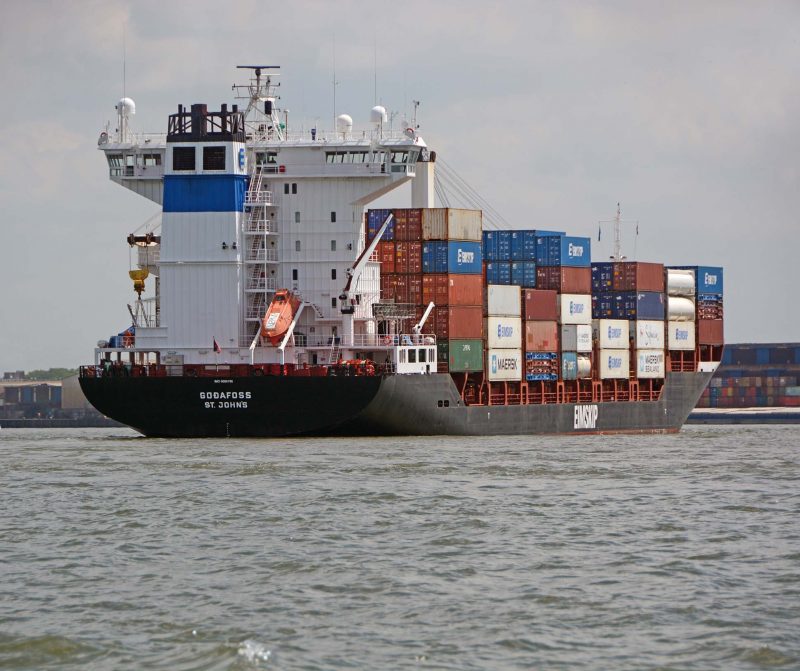
Two new Damen built container ships of 800 TEU capacity entered service in January, 2011 as Samskip Endeavour and Samskip Innovator. They are employed on the Geest North Sea and Irish services, with the first two voyages of Samskip Endeavour to Irish ports from Rotterdam, and the first two voyages of Samskip Innovator from Rotterdam to East Coast U.K. ports. They have blue hulls with curved white hoods on top of the fo’c’stle to protect containers from heavy weather damage. Thus, a new nomenclature has been introduced into the Samskip fleet, to supplement the traditional names of Icelandic waterfalls ending in ‘fell’.
The President of Iceland, Olafur Ragnar Grimsson, visited the Reykjavik offices of Samskip on 24th May 2011 and was given a tour of their domestic terminal and cold store and met thirteen new Samskip graduates from their Logistics School. The frequency of the Rotterdam service to Vigo, Leixoes and Lisbon was increased to three or four sailings per week from July 2011, and that of the Rotterdam service to Stavanger, Maloy, Haugesund, Bergen and Alesund was doubled to twice per week at the same time. Outsize 45 feet multimodal containers as well as 40 and 20 feet containers and all ro-ro trailers are accepted on these services.

Smyril Line And Others
There are other shipping companies operating in Iceland, such as Nesskip Hf, formed in 1974 by Capt. Gudmundur Asgeirsson and today operates the coastal tankers Freyja and Frigg, purchased in August 2001. The company also operates mini-bulkers that are chartered to the Wilson fleet of Bergen, the largest operator of mini-bulkers in Europe. Nes Hf was established in 1983 and today has four small ships sailing under NIS registry between the Continent and Iceland with the bird names of Lomur, Svanur, Haukar and Sunna. Oliudreifing Hf was established in 1995 by two Icelandic oil companies, and operates a fleet of bunkering vessels e.g. Keilir that serve the port of Reykjavik. The coastal tanker Stapafell completed at Lauenburg in Germany in 1979 for Samband Line was owned by this company until sold to Panama in June, 2001. Finally, there are also tourist sightseeing vessels for whale watching in Breidafjordur.
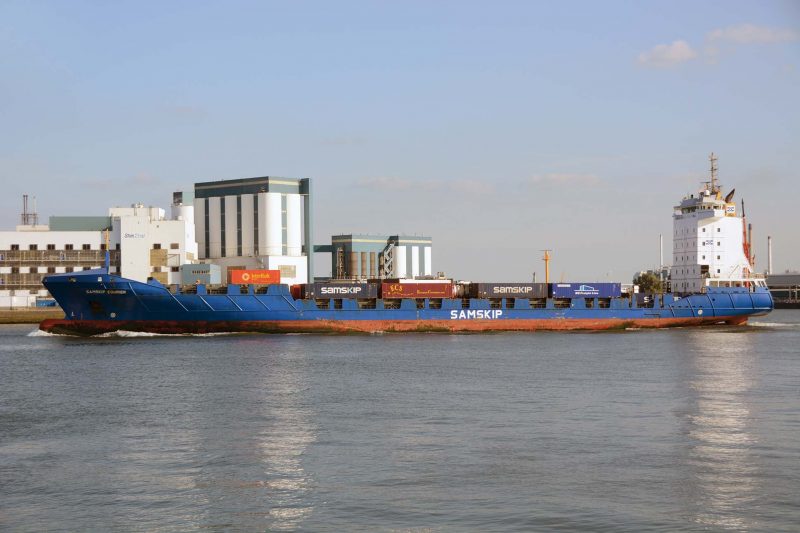
Although based in the Faroes, Smyril Line, founded in 1982, extends its weekly service from Denmark to Torshavn from April to October to Seydisfjordur in Iceland. Their passenger ferry for twenty years from the start of international passenger operations in 1983 was Norrona of 11,999 grt completed in May 1973 at the Nobiskrug Werft Gmbh yard at Rendsburg as Gustav Vasa for Swedish owners. She had accommodation for 750 berthed and 300 deck passengers with a service speed of 22 knots from Stork Werkspoor diesels, and operated to Torshavn from Denmark during the winter months and to Seydisfjordur in Iceland via Torshavn in the summer months, and she also operated to Norway and Lerwick in the Shetlands. Smyril Line is majority owned by the Faroese Government and Development Trust, with the Shetlands Development Trust also as a minority owner with a 6.8% stake.
Norrona was replaced in April 2003 by a new Norrona of 35,966 gt with accommodation for 1,012 berthed and 470 unberthed passengers. She has a service speed of 22 knots from four 6-cylinder Caterpillar oil engines producing 29,500 bhp, and her hull was launched from the Flender Werft AG yard at Lubeck, with fitting out by Flensburger Schiffbau Gmbh at Flensburg. She has to contend with very rough seas and has a pronounced angled ‘knuckle’ where the bow meets the main hull. She can carry 644 cars or ro-ro freight on 1,830 metres of lane length. These white hulled ferries with black funnels bearing the Smyril Line logo of the yellow and black head of the smyril bird, a merlin, make an annual appearance in the Tyne in early December. Their passengers arrive to buy woollen jumpers and Christmas presents at the Metrocentre in Gateshead at a great discount over those available in Norway and the Faroes. Thus, the Viking invasions of the days of old are very much still alive into Britain today. Smyril Line ceased sailings to Lerwick and to Norway during 2007/08, and have also recently moved all of its Danish ferry operations to the port of Hirtshals on the Skaggerak, ending services to Hanstholm (summer) and Esbjerg (winter).
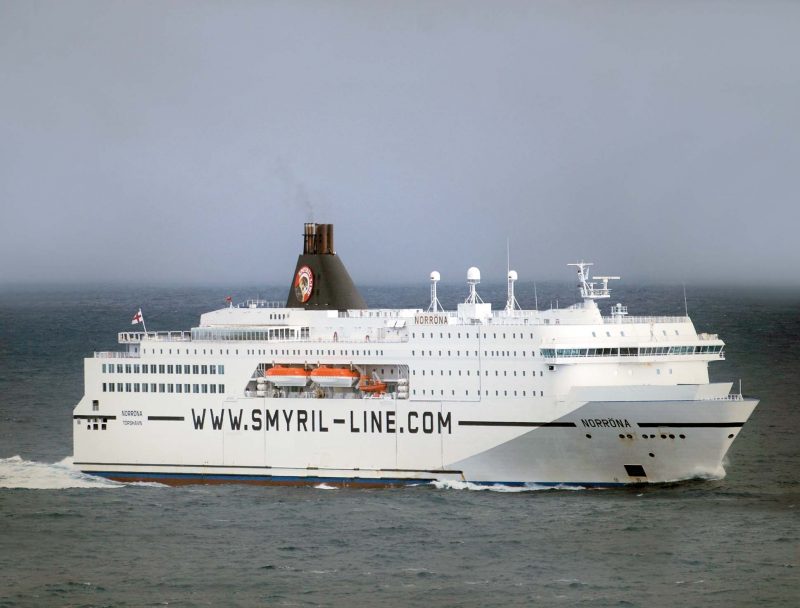
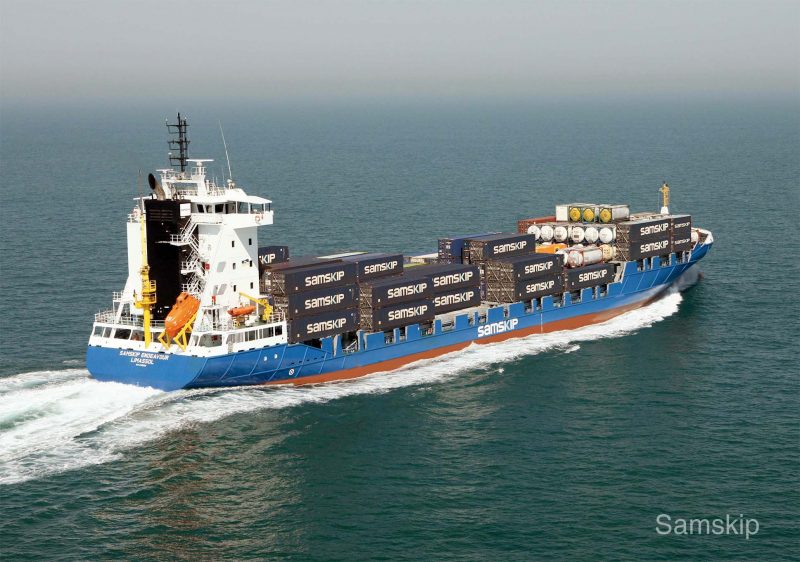

Comments
Sorry, comments are closed for this item